Didcot: The power station that inspired poetry
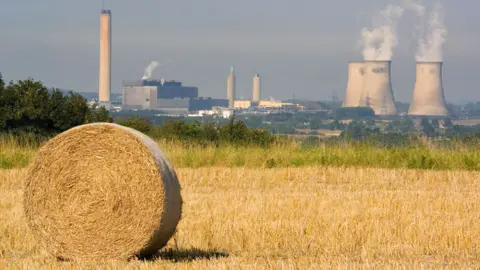 Alamy
AlamyBeautiful to some, a blot on the countryside to others, Didcot Power Station's monumental cooling towers have dominated the landscape of rural Oxfordshire for decades. But they will produce clouds of dust rather than steam when they are demolished on Sunday.
The power station's gigantic, concrete towers in the heart of Midsomer Murders country have stood in stark contrast to their surroundings for more than 50 years.
Public opinion is divided over the structure's good, bad, and ugly aspects. Some point to the jobs and communities it has created, while others highlight its 655ft (199.5m) smoke-belching chimney - one of the tallest structures in the UK - and say it is part of dirty industry they want to abolish forever.
Country Life readers voted the landmark Britain's third worst eyesore in 2003 and the site has long been the site of protests by environmentalists.
But to others the towers have been a source of inspiration.
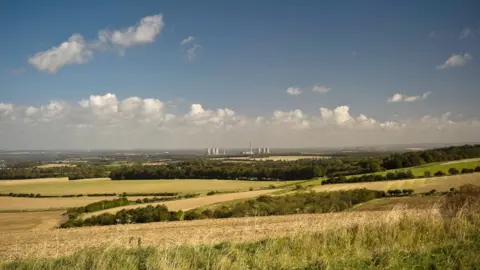 Alamy
AlamyThe novelist, Dame Marina Warner, who made a BBC documentary about the power station in 1991, described them as "like the dark satanic mills [but with] a sort of incredible furious beauty".
"It appealed to me because I just used to find the cooling towers very beautiful when I saw them from the road," she said. "The big streaming clouds of steam over this beautiful valley and also there were points to make. I wanted to make a point about the ecology.
"I just thought they should be recognised as achievements and also of expressions of a certain moment of triumphalism, a sort of human excessive triumphalism over nature which we now must say goodbye to."
To the poet Kit Wright, who published An Ode to Didcot Power Station in 2014, they are "a marvel of the plain".
 Kit Wright
Kit Wright"No-one would normally think that a coal power station was actually tremendously beautiful, but you get lured into it, you get to think it - so it becomes so," he said.
"The eye becomes accustomed to places and so does the heart really.
"It sort of earns its place it ones emotions. It'll be interesting to see what it looks like when nothing is there."
That enough people will be sad to see the towers go is possibly due to their design.
The architect Sir Frederick Gibberd, who had already designed Liverpool's Metropolitan Cathedral, took care to ensure the cooling towers and chimney were "sympathetic" to the landscape.
Artists Rachel Barbaresi and Susanna Round, who were commissioned to photograph the station prior to it being decommissioned, discovered Sir Frederick's early drawings of the power station at the back of a filing cabinet in the coal plant.
Plans from 1965 showed eight cooling towers standing together before Gibberd reduced the number to six and constructed them in two sets of three, a mile apart, to mitigate their visual impact.
"You cannot see it without being aware of the environmental consequences, but in terms of the design we found it very fascinating," Ms Barbaresi said.
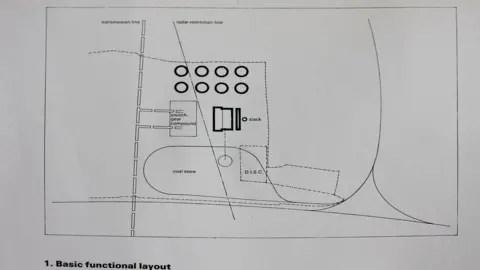 Barbaresi & Round, where clouds are made, 2013
Barbaresi & Round, where clouds are made, 2013 Barbaresi & Round, where clouds are made, 2013
Barbaresi & Round, where clouds are made, 2013So why was this concrete pile placed in the middle of the verdant Thames valley?
For the Central Electricity Generating Board (CEGB), which commissioned the power station back in 1964, it was a strategic decision.
The site, a former Ministry of Defence depot, was "freely available" to the government at the time, according to Lyn Bowen, who switched on the power station in 1970 and turned it off in 2013.
The town's railway line and proximity to the Thames also meant the location was right for the tonnes of coal and gallons of water the power station would require.
Despite local protests - employment benefits outweighed the landscape concerns - the six towers were completed in 1968, before the power station joined the National Grid in 1970.
During its construction, a recruitment campaign was launched in areas where heavy industry jobs had been cut, but experienced workers remained.
At the age of 25, Des Healy, had already been made redundant three times from jobs in Glasgow's shipyards and steel works.
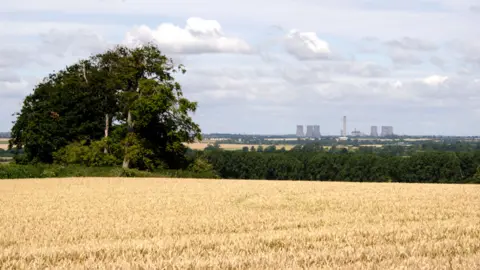 Alamy
AlamyUnemployed and with a young family, the skilled engineer signed up and moved to Didcot.
"We went to a local library to ask where Didcot was and I had three little librarians with maps of the south of England trying to find out and making phone calls," he laughed.
"One guy said I think it is in Oxfordshire and the second question was 'Where is Oxfordshire?'."
The 72-year-old said journeys like his were not uncommon, with workers drafted in from industrial areas in Scotland, northern England and south Wales.
Mr Healy would go on to become a senior shop steward and retire after 28 years in the town, where he still lives today.
The arrival of new employees saw houses built and new communities forged as the historic railway town entered a new era and identity.
 Ed Nix
Ed NixLyn Bowen, who moved to the area to run the plant, said the "only thing missing" when he first visited Didcot was "tumbleweed".
The 79-year-old remembers the excitement he felt, flicking the switch in the control room as the power station was turned on.
"All the pieces had been put together and it works," he recalled.
From that day, its boilers consumed 185 tonnes of coal every hour, which was burned to raise the temperature of the steam so high - 568C - so that it powered four mighty turbines.
The turbines then spun a generator rapidly to produce 2,000 megawatts (MW) of electricity to power millions of homes. The steam, still roaring hot, was condensed and allowed to escape through the six giant cooling towers.
But despite an increase in jobs and prosperity, Mr Healy said opinions were always split on the station.
"A lot of people felt it was dirty and noisy, which it was, because coal by virtue of what it is, coal is dirty," he said.
"If this power station had been built on the Clyde or the Tyne, I'm sure there would be a different attitude because all the money and jobs it brought to this area - those areas would have welcomed it with open arms."
Mr Healy, who became a Labour councillor and was mayor between 2015 and 2016, said he "always wanted to give back" because "Didcot was good to me and my family".
After new EU reduced emissions rules were brought in, the owners RWE Power decided to decommission the power station in 2013.
The three southern cooling towers were demolished a year later, but in February 2016, as engineers prepared the rest of the site for demolition, tragedy struck.
The 10-storey boiler house collapsed, killing workers Ken Cresswell, 57, John Shaw, 61, Michael Collings, 53, and Christopher Huxtable, 34. It took more than six months for their bodies to be recovered from the site.
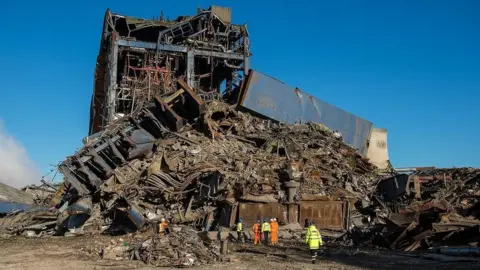 Thames Valley Police
Thames Valley PoliceThree years on, investigators have examined 870 tonnes of the collapsed structure and Thames Valley Police and the Health and Safety Executive (HSE) are investigating possible manslaughter and health and safety offences.
Mr Bowen said it was a "poignant moment" when he switched off Didcot A after 43 years of service.
"The big sadness I have got with it going is that it reflects the end of British Engineering," he said. "It's the end of an era."
Mr Healy, who says he will watch the towers come down with his family, added: "People who are happy to see it come down will be rejoicing.
"People like myself who were brought out of unemployment and who were given secure futures for our families will think of the good times it brought us."
The future of the site is not known, although more than 15,000 new homes are set to be built in the area over the next 20 years.
Perhaps these developments will signal the start of another new era for the town, with new families moving in just as the power station workers did in the 1970s.
The government plans to phase out the UK's last coal-fired plants by 2025 to reduce carbon emissions.
Dame Marina believes the architects of such stations should not be "vilified".
"The work these buildings were doing was for everybody," she says. "This was the engine of society - this kind of fuel consuming and fuel making machine."
Between 06:00 and 08:00 BST hundreds will watch on as the three northern cooling towers are blown down, leaving the giant chimney to stand alone until the autumn.
The Oxfordshire skyline will never look the same again.
 Getty Images
Getty Images